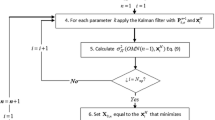Abstract
A geostatistics-based methodology is proposed to evaluate existing groundwater quality monitoring networks by considering the spatial correlation of various physicochemical parameters and the aquifer vulnerability index simultaneously, using the weighted normalized estimate error variance of all variables as the optimization criterion to be minimized. The DRASTIC method was chosen to determine the vulnerability index. The methodology requires a covariance matrix for each variable that is obtained from a geostatistical analysis of the corresponding data. Each matrix is normalized to give the same initial weight to each parameter, whereas different weights can be specified later during the optimization process, depending on the monitoring goals. The vulnerability index is used in the evaluation to include areas within the aquifer that are highly susceptible to contamination. Two optimization strategies are presented. In the first strategy, the vulnerability index is included as an additional variable during the optimization process and more weight is assigned to this variable than to the others. In the second strategy, the optimization process seeks to minimize the total weighted variance, prioritizing the areas with the highest vulnerability index values. For the estimation, the static Kalman filter, which requires an initial estimate, was chosen and its error covariance matrix for each variable is involved in the evaluation. Employing successive-inclusions optimization, the contribution of each monitoring well in reducing the estimate error variance for all parameters at predefined estimation points is evaluated and those that reduce the variance the most are retained in the optimal monitoring network.








Similar content being viewed by others
References
Aller L, Bennett T, Lehr JH, Petty R, Hackett G (1987) DRASTIC: a standardized system to evaluate groundwater pollution using hydrogeologic settings. US environmental protection agency report 600/2-87/035. http://nepis.epa.gov/Exe/ZyPURL.cgi?Dockey=20007KU4.TXT. Accessed 15 June 2015
Andreo B (2004) Cartografía de vulnerabilidad a la contaminación de acuíferos. In: Fernández L, Ruiz L, Fernández JA, López JA (eds) Protección de las aguas subterráneas frente a vertidos directos e indirectos, 13th edn. Publicaciones del instituto geológico y minero de España, Serie: Hidrogeología y aguas subterráneas No 13. Granada, España, pp 55-78
Chadalavada S, Datta B, Naidu R (2011) Uncertainty based optimal monitoring network design for a chlorinated hydrocarbon contaminated site. Environ Monit Assess 173:929–940. doi:10.1007/s10661-010-1435-2
CONAGUA. Comisión nacional del agua (2009) Actualización de la disponibilidad media anual de agua subterránea del acuífero (3225) Calera. Diario oficial de la federación. México. http://www.conagua.gob.mx/Conagua07/Aguasubterranea/pdf/DR_3225.pdf. Accessed 15 June 2015
CONAGUA. Comisión nacional del agua (2013) Estadísticas del agua en México. Secretaría de medio ambiente y recursos naturales. México. http://www.conagua.gob.mx/CONAGUA07/Noticias/SGP-2-14Web.pdf. Accessed 15 June 2015
COTAS. Comités técnicos de aguas subterráneas acuíferos Aguanaval, Calera y Chupaderos, (2008) Plan hídrico de los acuíferos Aguanaval. Calera y Chupaderos en el Estado de Zacatecas, México
Delhomme JP (1978) Kriging in the hydrosciences. Adv Water Resour 1(5):251–266. doi:10.1016/0309-1708(78)90039-8
Dutta D, Das Gupta A, Ramnarong V (1998) Design and optimization of a ground water monitoring system using GIS and multicriteria decision analysis. Ground Water Monit R 18(1):139–147. doi:10.1111/j.1745-6592.1998.tb00610.x
Hergt T (2009) Diseño optimizado de redes de monitoreo de la calidad del agua de los sistemas de flujo subterráneo en el acuífero 2411 “San Luis Potosí”: Hacia un manejo sustentable. Universidad Autónoma de San Luis Potosí, Tesis de doctorado
Herrera GS (1998) Cost effective groundwater quality sampling network design. Ph. D. Dissertation, University of Vermont. http://citeseerx.ist.psu.edu/viewdoc/download?doi=10.1.1.383.9759&rep=rep1&type=pdf. Accessed 15 June 2015
Herrera GS, Júnez-Ferreira HE, González L, Cardona A (2004) Diseño de una red de monitoreo de la calidad del agua para el acuífero Irapuato-Valle. Memorias del XVIII congreso nacional de hidráulica, AMH. SLP, México, Guanajuato
Herrera GS, Pinder GF (2005) Space-time optimization of groundwater quality sampling networks. Water Resour Res 41(12):W12407. doi:10.1029/2004WR003626, http://onlinelibrary.wiley.com/doi/10.1029/2004WR003626/full. Accessed 15 June 2015
INEGI. Instituto nacional de estadística y geografía, (2013) Proyecto de información básica. Mapa digital para escritorio, México
Jazwinski AH (1970) Stochastic processes and filtering theory. Academic Press, London
Júnez HE (2005) Diseño de una red de monitoreo de la calidad del agua para el acuífero Irapuato-Valle, Guanajuato. Tesis de maestría, UNAM, México. http://132.248.9.195/ptd2012/anteriores/0339152/Index.html. Accessed 15 June 2015
Júnez-Ferreira HE, Bautista-Capetillo CF, González J (2013) Análisis geoestadístico espacial de cuatro iones mayoritarios y arsénico en el acuífero Calera, Zacatecas. Tecnología y Ciencias del Agua 4:175-181
Júnez-Ferreira HE, Herrera GS (2013) A geostatistical methodology for the optimal design of space-time hydraulic-head monitoring-networks and its application to the Valle de Querétaro aquifer. Environ Monit Assess 185(4):3527–3549. doi:10.1007/s10661-012-2808-5
Li J, Bárdossy A, Guenni L, Liu M (2011) A Copula based observation network design approach. Environ Modell Softw 26:1349–1357. doi:10.1016/j.envsoft.2011.05.001
Lin Y, Rouhani S (2001) Multiple-Point variance analysis for optimal adjustment of a monitoring network. Environ Monit Assess 69:239–266. doi:10.1023/A:1010767022936
Narany T, Ramli M, Aris A, Sulaiman W, Fakharian K (2013) Spatial assessment of groundwater quality monitoring wells using indicator kriging and risk mapping, Amol-Babol plain, Iran. Water 6:68–85. doi:10.3390/w6010068
Núñez EP (2003) El acuífero de Ca2003lera, Zacatecas, situación actual y perspectivas para un desarrollo sustentable. Universidad autónoma de Nuevo León, Tesis de maestría
Okeyo JM, Shepherd KD, Wamicha W, Shisanya C (2006) Spatial variation in soil organic carbon within smallholder farms in western Kenya: a geostatistical approach. Afr Crop Sci J 14(1): 27–36. http://www.bioline.org.br/pdf?cs06003. Accessed 15 June 2015
Reyes JE (2014) Metodología geoestadística que involucra la vulnerabilidad en el diseño de redes de monitoreo de la calidad del agua subterránea: Aplicación Calera, Zacatecas. Orientación en recursos hidráulicos, Zacatecas, México, Tesis de maestría, Maestría en ingeniería aplicada
Samper FJ, Carrera J (1990) Geoestadística, aplicaciones a la hidrogeología subterránea. Centro internacional de métodos numéricos en ingeniería, Universidad politécnica de Cataluña, Barcelona
Webster R, Oliver M (2007) Geostatistics for environmental scientists. Wiley, UK
Yeh M, Lin Y, Chang L (2006) Designing an optimal multivariate geostatistical groundwater quality monitoring network using factorial kriging and genetic algorithms. Environ Geol 50:101–121. doi:10.1007/s00254-006-0190-8
Author information
Authors and Affiliations
Corresponding author
Rights and permissions
About this article
Cite this article
Júnez-Ferreira, H., González, J., Reyes, E. et al. A Geostatistical Methodology to Evaluate the Performance of Groundwater Quality Monitoring Networks Using a Vulnerability Index. Math Geosci 48, 25–44 (2016). https://doi.org/10.1007/s11004-015-9613-y
Received:
Accepted:
Published:
Issue Date:
DOI: https://doi.org/10.1007/s11004-015-9613-y




